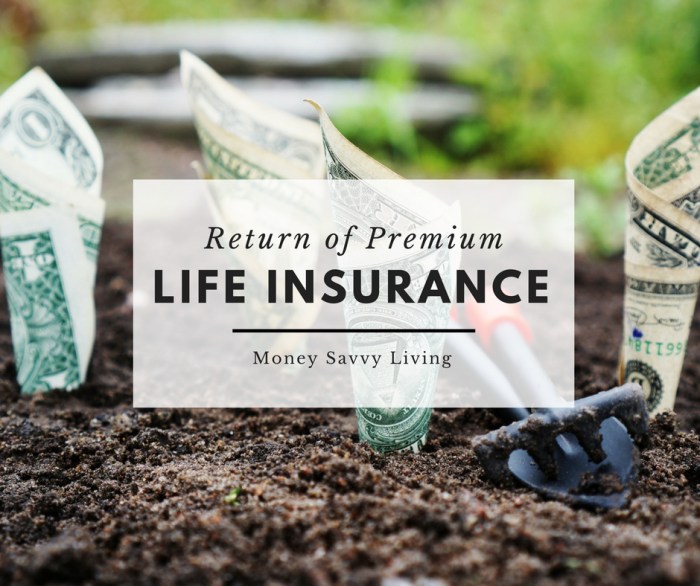Return of premium (ROP) life insurance offers a unique proposition: the potential to recoup your premiums if you outlive the policy term. This intriguing feature, however, comes with a price tag significantly higher than traditional term life insurance. Understanding the intricacies of ROP policies – their advantages, disadvantages, and suitability for various financial situations – is crucial before making a decision that could significantly impact your long-term financial well-being.
This comprehensive guide delves into the core mechanics of return of premium life insurance, comparing it to traditional term life insurance and exploring scenarios where it shines and where it falls short. We’ll analyze the financial implications, tax considerations, and overall cost-effectiveness to equip you with the knowledge needed to make an informed choice.
Disadvantages of Return of Premium Life Insurance

Return of Premium (ROP) life insurance, while attractive for its promise of a premium refund, comes with several potential drawbacks that prospective buyers should carefully consider. Understanding these limitations is crucial to making an informed decision about whether this type of policy aligns with your individual financial goals and risk tolerance. It’s not a one-size-fits-all solution, and a thorough cost-benefit analysis is essential.
ROP policies often appear appealing due to the promise of receiving all premiums back if the insured survives the policy term. However, this benefit comes at a significant cost, which is a key disadvantage. The higher premiums associated with ROP policies can substantially outweigh the potential benefits for many individuals, especially when compared to alternative investment strategies or traditional term life insurance.
Higher Premium Costs
The most significant disadvantage of ROP life insurance is the substantially higher premium cost compared to traditional term life insurance or whole life insurance policies offering similar death benefit coverage. This is because a portion of each premium payment is set aside to fund the eventual return of premiums, reducing the amount allocated to the death benefit. For example, a 20-year, $500,000 ROP policy might cost significantly more annually than a comparable term life policy, potentially doubling or even tripling the annual premium. This increased cost should be carefully weighed against the potential return of premiums at the end of the policy term. The higher premiums effectively reduce the amount available for investment or other financial goals.
Cost-Effectiveness Compared to Other Investment Options
The cost-effectiveness of ROP life insurance needs to be assessed in relation to other investment options. While the return of premiums offers a degree of security, the potential returns might be lower than those achievable through alternative investments, such as index funds or diversified mutual funds, particularly over the long term. The guaranteed return of premiums might not keep pace with inflation or potentially higher returns offered by actively managed investments, resulting in a net loss of purchasing power. For instance, if an individual invested the difference in premium costs between a ROP policy and a traditional term policy in a diversified portfolio with a reasonable average annual return, they might accumulate a significantly larger sum than the returned premiums at the end of the policy term.
Scenarios Where ROP Policies Might Not Be Financially Advantageous
It’s crucial to consider various scenarios where a return of premium policy might not be the most financially sound choice.
- Death Before Policy Maturity: If the insured dies before the policy’s term expires, the beneficiaries receive the death benefit, but the premiums are not returned. This negates the primary advantage of the ROP policy.
- Lower-Than-Expected Investment Returns: If the premiums saved by choosing a less expensive traditional life insurance policy are invested and yield higher returns than the guaranteed return of premiums in the ROP policy, the individual would have been better off financially.
- Unforeseen Financial Needs: The higher premiums paid for ROP insurance could have been used to address other urgent financial needs, such as paying off high-interest debt, funding education, or making a significant down payment on a property.
- Changes in Life Circumstances: Significant life changes, such as a change in employment, marital status, or family size, might alter an individual’s life insurance needs. The higher premium commitment of a ROP policy might become a burden if circumstances change.
- Tax Implications: The tax implications of both the premiums paid and the returned premiums should be carefully considered, as they can affect the overall financial benefit.
Scenarios Where Return of Premium Life Insurance is Unsuitable
Return of Premium (ROP) life insurance, while attractive for its promise of a full premium refund, isn’t always the best financial choice. Several scenarios highlight its potential drawbacks and demonstrate when alternative financial strategies might be more beneficial. Understanding these scenarios is crucial for making informed decisions about your life insurance needs.
ROP life insurance’s core appeal lies in the premium refund. However, this feature comes at a cost – typically higher premiums compared to traditional term or whole life insurance policies. This higher cost can negate the benefits if certain circumstances arise.
Early Death
The primary purpose of life insurance is to provide financial protection for dependents in the event of the policyholder’s death. If death occurs early in the policy term, the beneficiary receives the death benefit, but the policyholder doesn’t get the return of premiums. In this scenario, the higher premiums paid for ROP insurance represent a significant financial loss compared to a less expensive term life insurance policy that would have provided the same death benefit at a lower cost. For example, a 35-year-old purchasing a 20-year ROP policy who dies at age 40 would not receive the return of premiums, resulting in a net loss compared to a comparable term life policy.
Changing Financial Situations
Life is unpredictable. Significant life changes, such as job loss, unexpected medical expenses, or a major investment loss, can strain personal finances. Continuing to pay higher premiums for ROP insurance during these challenging times might become unsustainable, forcing policy lapse and forfeiting the potential return of premiums. A more flexible and affordable option, like a term life policy that can be adjusted or cancelled, could prove more suitable in such situations.
Alternative Investment Opportunities
The premiums paid for ROP insurance could potentially be invested elsewhere to achieve similar or better returns. For individuals with a high risk tolerance and strong financial planning skills, investing the premium difference between ROP and a more basic term life policy in a diversified portfolio could potentially yield higher returns over the long term. This approach, however, requires a higher level of financial literacy and comfort with investment risk. For example, instead of paying the higher premiums for ROP, the extra funds could be invested in a low-cost index fund, potentially generating greater wealth over time.
Comparison with Alternative Financial Products
The suitability of ROP insurance varies significantly depending on life stage and financial goals. For younger individuals with limited financial resources, a term life insurance policy providing adequate death benefit coverage at a lower cost may be more appropriate. As individuals age and their financial situation improves, they might consider whole life insurance or other investment vehicles alongside term life coverage. In retirement, the need for life insurance may diminish, and the funds previously allocated to ROP could be better used for retirement income generation or healthcare expenses. A comprehensive financial plan considering all aspects of life stages should guide the choice of life insurance product.
Illustrative Examples

This section provides a hypothetical comparison between return of premium (ROP) and traditional term life insurance policies over a 20-year period, illustrating potential financial outcomes under various scenarios. We will examine both scenarios where the insured dies during the policy term and scenarios where the insured survives the entire term. This comparison will highlight the key differences in cost and potential return on investment.
Return of Premium vs. Traditional Term Life Insurance: A 20-Year Comparison
Let’s consider a 40-year-old male seeking $500,000 in life insurance coverage for 20 years. We’ll assume two policy options: a traditional term life insurance policy and a return of premium policy. For simplicity, we will ignore any potential investment gains on the returned premiums in the ROP scenario.
Scenario 1: Death Occurs Within the 20-Year Term
Suppose the insured dies after 10 years.
| Policy Type | Annual Premium | Total Premium Paid (10 years) | Death Benefit | Net Outcome |
|---|---|---|---|---|
| Traditional Term | $1,000 | $10,000 | $500,000 | $490,000 net benefit |
| Return of Premium | $1,500 | $15,000 | $500,000 | $485,000 net benefit |
In this scenario, both policies provide a substantial death benefit. The traditional term policy has a higher net benefit due to lower premiums.
Scenario 2: Insured Survives the Entire 20-Year Term
Now, let’s assume the insured survives the full 20 years.
| Policy Type | Annual Premium | Total Premium Paid (20 years) | Death Benefit | Return of Premium | Net Outcome |
|---|---|---|---|---|---|
| Traditional Term | $1,000 | $20,000 | $0 | $0 | -$20,000 (cost of insurance) |
| Return of Premium | $1,500 | $30,000 | $0 | $30,000 | $0 (premiums returned) |
Here, the ROP policy returns all premiums paid, resulting in a net outcome of zero. The traditional term policy results in a net loss equal to the total premiums paid.
Visual Representation of Premium Payments and Returns
A graph depicting this data would show two lines. The traditional term policy line would represent a steady increase in total premiums paid over 20 years, ending at $20,000 with a flat line representing zero death benefit. The ROP policy line would similarly show an increase in total premiums paid, reaching $30,000, but then a sharp upward spike at year 20 representing the return of the $30,000 in premiums. This visual representation clearly highlights the difference in financial outcomes depending on whether the insured survives the policy term. The Y-axis would represent total dollars, and the X-axis would represent the time in years.
Final Review

Ultimately, the decision of whether or not to purchase return of premium life insurance hinges on individual circumstances, financial goals, and risk tolerance. While the promise of a premium refund is appealing, it’s essential to weigh the higher costs against potential alternative investment strategies. By carefully considering the pros and cons Artikeld here, and consulting with a qualified financial advisor, you can determine if ROP insurance aligns with your specific needs and long-term financial plan.
Helpful Answers
What happens if I die before the policy expires with a return of premium policy?
Your beneficiaries will receive the death benefit, just as with a traditional life insurance policy. The return of premium feature only applies if you survive the policy term.
Are there tax implications on the returned premiums?
The tax implications can vary depending on your location and specific policy details. It’s crucial to consult with a tax professional to understand the potential tax consequences of receiving the returned premiums.
Can I withdraw my premiums before the policy expires?
Generally, no. Return of premium policies typically don’t allow for withdrawals before the policy term ends. The return of premium is contingent upon the policy reaching its maturity date.
How does the cost of a return of premium policy compare to a whole life policy?
ROP policies generally have higher premiums than traditional term life insurance but are usually less expensive than whole life insurance, which builds cash value over time. The cost comparison depends on factors like age, health, and coverage amount.